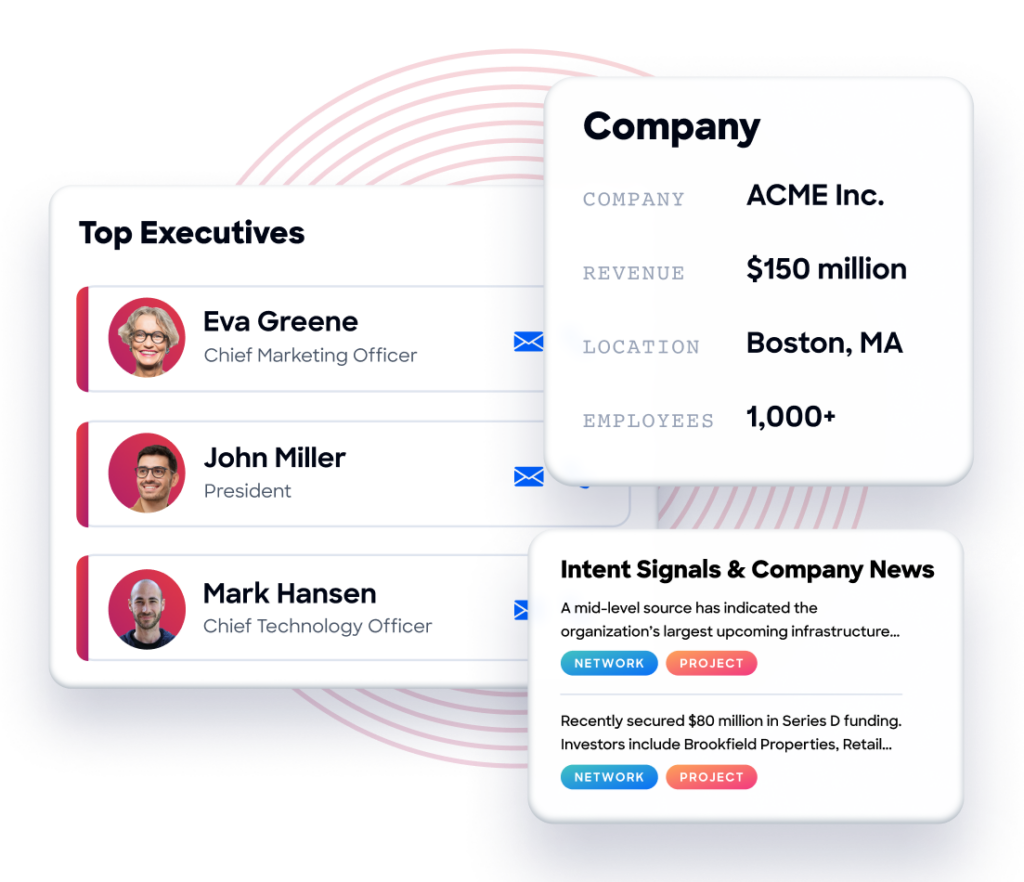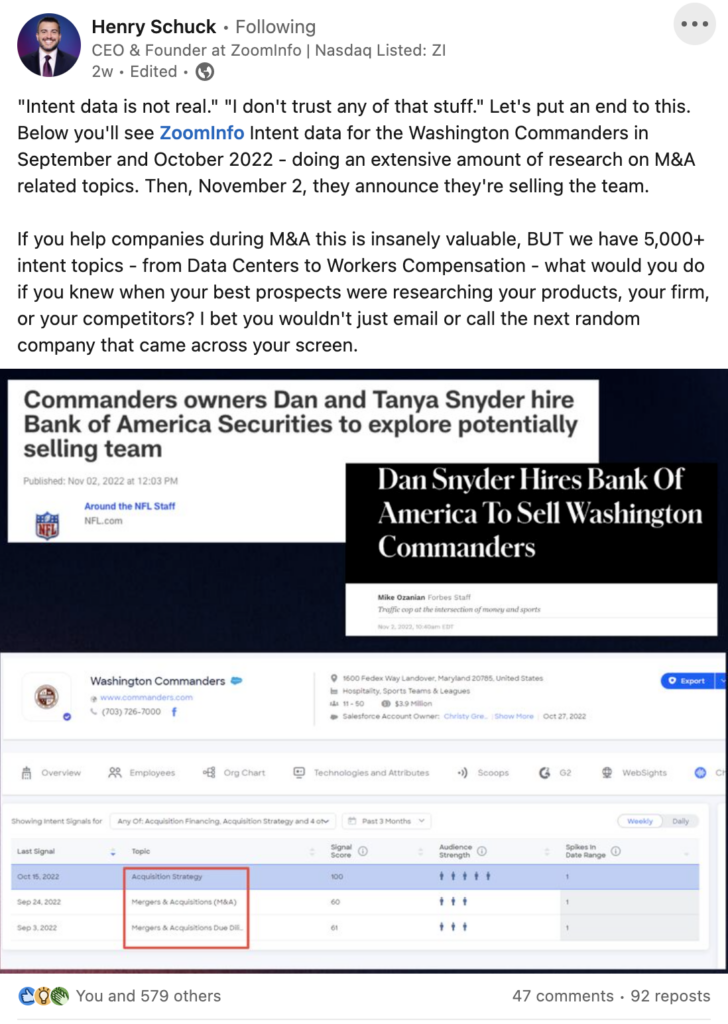It’s enough to ruin any sales professional’s quarter: that prospect your team has spent months engaging — scheduling demos, addressing concerns, comparing features — suddenly decides they’re not ready to buy after all.
You can’t stop every account from getting cold feet or misreading their company’s appetite for new solutions. But today’s best-performing go-to-market (GTM) teams are increasingly using intent data to focus their efforts on the accounts that are the most likely to close a deal.
With intent data, your sales team can identify the highest-value prospects in the market and prioritize their outreach to match the account’s position in the buying journey.
In a market that rewards efficiency, scalability, and automation, intent data can be the ingredient that helps GTM teams of all sizes unlock their potential and win faster than ever. Here’s how it works.
Understanding Intent Data
Intent data captures the digital footprints left behind when prospects research products and services, generating signals that help inform sales, marketing, and business strategy decisions. This information can be analyzed to identify account intent, or how likely prospects at a particular company are to engage with a particular vendor.
Intent data can be collected from a variety of sources across the web, including review sites, news articles, and product research. When these signals are sorted into distinct topics, with high amounts of activity interpreted as “spikes” in intent, sellers can make much more informed decisions about their target audience’s needs and interests.
For example, if several people within an account are browsing content tied to the term “best B2B sales software vendors,” you can infer the company has relatively high intent to make a purchase in that sector.
Ways to Incorporate Intent Data in Your Sales Strategy
Research by McKinsey found that more than 70% of businesses are willing to switch vendors if their “must haves” are not met during their buying journey. One of the best ways to avoid this common pitfall is ensuring a personalized buying experience for every prospect — something that sales reps can achieve by using intent data.

There are four key approaches sales teams should consider when seeking to implement intent data: ongoing account prioritization, customizing talk tracks, identifying upsell opportunities, and understanding market trends.
1. Ongoing account prioritization
By analyzing website visits, search behavior, and engagement with marketing materials, intent signals can help prioritize the accounts that show a higher propensity to buy.
For example, you likely have more target accounts than your sales reps can follow up within a given timeframe, so you need to prioritize the most important ones. Incorporating intent data as a part of a lead scoring model can help accurately segment your leads into high, medium, and low priority groups.
It’s important to note that even prospects with high intent may not convert in the end. However, focusing on accounts that are further along in the buying process will ultimately increase your team’s chances of success.
2. Customizing talk tracks
By assessing a prospective account’s online behavior and interactions with marketing materials, intent data can reveal valuable information — which product features or benefits they’re interested in most, the biggest challenges they’re facing, and the goals they’re trying to achieve. This enables sales reps to customize their talk tracks to suit each prospect’s needs.
“A cold conversation gets very warm when you’re focused on an audience that’s researching about a pain point, or a product, or a problem to be solved,” says Will Frattini, a principal strategic account manager at ZoomInfo.
If one group of accounts has relatively little intent to purchase, you can send them thought leadership materials that address common problems. If another group of accounts has strong intent to purchase, reps could send them solution-focused content and direct response offers, like “get a demo” or “start your free trial.”
By customizing talk tracks, sales reps can build stronger relationships with prospects and increase their chances of closing deals.
3. Identifying upsell opportunities
Intent data can also proactively identify upsell and cross-sell opportunities with existing customers, allowing sales teams to prioritize those accounts.
Let’s say you’re a sales rep for a B2B software company that sells project management solutions. You have a customer who’s been using your basic software package for a while now, but intent signals show that they recently started researching more advanced features.
With this context, you can reach out to the customer with a targeted offer to upgrade their package. In doing so, you not only increase your revenue, but you strengthen your relationship by offering them a solution that meets their specific needs.
Intent data can also show an increase in activity on certain topics that may indicate risk at a top account, such as topics related to severance pay options or layoffs. Seeing these indicators in real time before the news breaks gives your team a heads up to strategize and prepare for any unexpected challenges along the way.
By using intent data to anticipate customers’ needs and offering them relevant solutions, sales reps can increase revenue, build stronger relationships, and differentiate themselves from the competition.
4. Understanding market trends
Intent data gives sales reps a real-time view of what’s happening in their industry, including what their competitors are up to, which products and services are in high demand, and what trends are on the horizon.
Let’s say you sell a range of cloud-based solutions for businesses in the finance sector. By using intent data, you can identify which industries are showing the most interest in those services and which specific solutions are most in demand. This can help you tailor your sales pitch to the needs of each industry and highlight the benefits of your specific solutions.
Intent data can also help sales reps stay up to date on emerging trends and changes in their market. For example, if you’re selling to the healthcare industry, intent data can help identify changes in regulations or new technologies that are likely to impact your customers’ needs.

Here’s another example from ZoomInfo CEO Henry Schuck. By using intent data, you can see how key terms such as “mergers and acquisitions” spike ahead of a major deal announcement. With real-time insights, your team will be up to date with the latest news, market changes, or trends that are happening in your industry.
How to Convert A-List Accounts Using ZoomInfo Intent
We launched our own proprietary intent feature with the goal of resolving two of the most common challenges associated with traditional intent data: qualifying actual intent and identifying which companies are spiking on those topics.
ZoomInfo Intent is fueled by world-class natural language processing (NLP) technology, which helps weed out data that might otherwise mistakenly show intent that isn’t really there.
Let’s say we set up an intent signal for “ZoomInfo.” Our NLP technology would automatically analyze content that mentions the company and determine if an article is focused solely on ZoomInfo, or only mentions it in passing,, like an article that discusses several tech-company stocks.
Our IP-to-company graph can also convey whether a small or large group of people at any given company location are exploring the intent topics being tracked, and show how that activity compares to historical trends.
The best part? The data is delivered when and where it’s needed, giving sales reps immediate notification when a key prospect is showing a high level of interest in a specific topic.
“Having ZoomInfo is like having night-vision goggles. It gives the reps the ability to see what’s going on, who’s showing intent, who we should be talking to, and where the probability of conversion is far higher,” says Daniel Reeve, director of sales and business development at Esker Inc.
Key Takeaways
Adding intent data to your sales strategy can give your team a powerful edge, providing real-time insights into the interests and behaviors of your target market and illuminating the best time to engage — as well as what messages or offers will be most relevant.
By leveraging intent data, your sales team can:
Prioritize the highest-value prospects
Deliver more relevant, personalized experiences
Identify red flags and upsell opportunities with your customers
Stay informed on the market trends and news that could impact your pipeline
Whether you’re looking to accelerate the buyer’s journey, increase conversion rates, or simply stay ahead of your competition, integrating intent data into your sales strategy is a must for any modern business. See how ZoomInfo Intent can help your GTM team unlock insights today.


